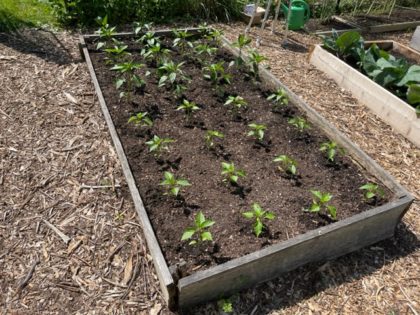Meditation Group

The Middlestream Mindfulness Meditation Group meets at the Fellowship building twice a month, usually every other Tuesday at 7pm. The group welcomes new members.
If you have any questions or would like to join us, please contact Jim Galik at galikjames96@gmail.com.
The Ligonier Giving Garden ended with the 2022 season. After some discussion with UUFLV board members, it was decided to change it to a Pollinator Garden for the 2023 season. Planning is underway now and work on the new garden is expected to begin in April/May. Stay tuned for more information!
A New Name for a New Season 2022- Ligonier Giving Garden
(formerly known as Greenacres Garden)
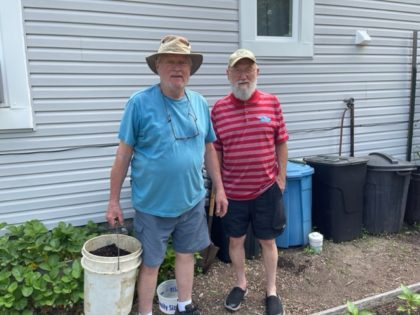
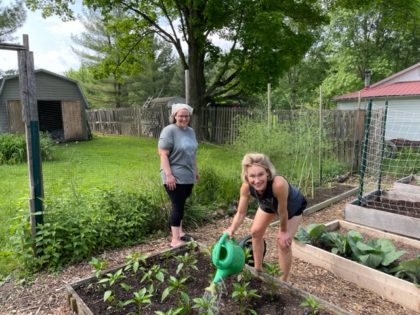
Left- Mike Cook and Monte Holland
Right- Michelle Lenhart and Jess Vogelsang
The Ligonier Giving Garden members, pictured above, regrouped for the 2022 season. The first meeting of the season held in mid-January was very productive. A summary of their decisions is below:
- Invite all volunteers to FB Messenger convo for communication. This chat will be used to communicate all duties that need covered in the garden.
- Future meetings will ideally be during the garden work days, where we can chat and work at the same time.
- Free CSA style distribution to a few families that qualify. Jess is taking the lead on this. Depending on yield and how harvests fall, we may donate to End Hunger Cafe and the local food pantry.
- We decided on the following for planting: 2 beds for tomatoes, using cattle panels like last year. Under those tomatoes we may plant radishes and lettuce.1.5 beds green/red peppers, .5 bed wax/banana peppers, 1 bed carrots, 1 bed beets, 1 bed cucumbers, 2 beds of zucchini, and 1 bed of bush beans.
- Mike is going to take the lead on the rain barrels and composting.
- We need to add kitchen scraps to the composting. We also need a new trash can for holding donated kitchen scraps. Mike is going to pick that up.
The garden consists of 8 beds that are approximately 4′ x 8′ (256 sq. ft.) and two beds are approximately 3′ x 7′ ( 42 sq. ft.). Seed was ordered from Johnny’s Select Seeds (organic where possible) and a rough sketch of garden layout was done.
A proposed plan for the beds was made:
Odd numbered beds on west side of garden and even numbered on east.
Beds 1 and 3 to have cattle panels with tomatoes on the outside and lettuce, spinach, and kale under arch.
Bed 2 peppers
Bed 4 peppers (half bell and half bannana)
Bed 5 beets
Bed 6 carrots
Bed 7 Bush beans
Bed 8 cucumbers
Beds 9 and 10 zucchini
As to be expected, when planting got underway, some adjustments were made to the plan.
When weather permitted, the prep work began. Repairs to a couple garden beds were done and the soil was tested and amended where it was needed. Mike made contact with a local Master Gardener, Cary Caspersen, who shared his expertise and donated some plants. Early season plantings were done in May and more seeds and plants were added June 1. Some of those photos are below.
A Sampling of the Beds.
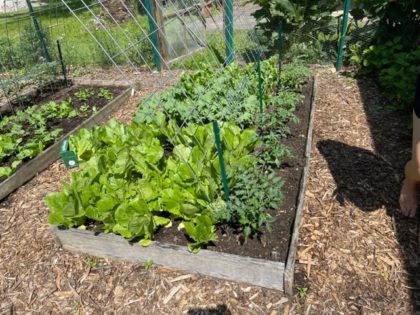
Left- Bed # 1- Tomatoes, Lettuce, Kale, and Spinach
Right- Bed #4- Green/Red Peppers and Banana Peppers
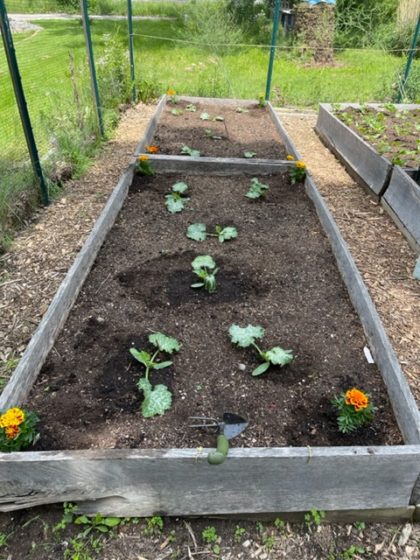
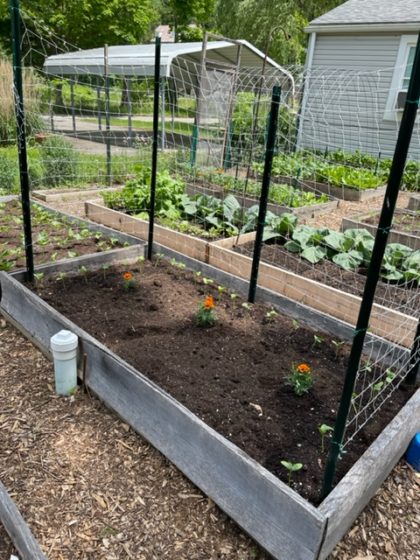
Left- Beds # 10 & 9- Zucchini
Right-Bed # 8- Cucucumbers around the perimeter
Rain Barrels Supply the Water
In late March, Mike and his wife Kathy cleaned the six rain barrels that were stored in the shed. Next the gutters were cleaned and the connection to the six rain barrels was completed.
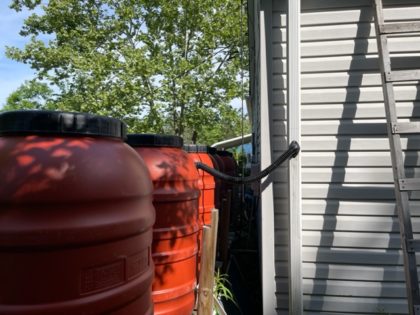
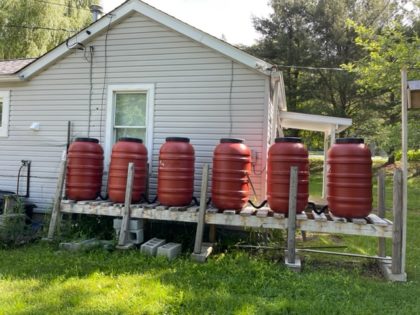
A large container filled with water from the bins is located inside the garden. Watering cans are nearby and can be dipped in the container to water the beds when needed. As the bin gets low on water, more is added from the rain barrels.
History of the Greenacres Garden- 2018 to 2020
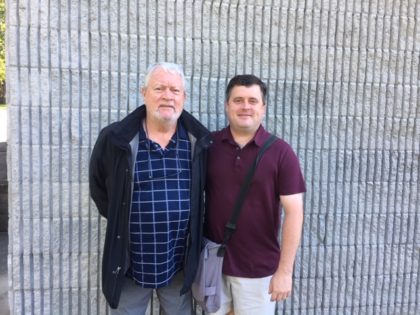 Greenacres Garden is a community garden located on our Unitarian Universalist Fellowship of Ligonier Valley (UUFLV) property. Workers plant, weed, water and harvest the crops then deliver them to area food pantries.
Greenacres Garden is a community garden located on our Unitarian Universalist Fellowship of Ligonier Valley (UUFLV) property. Workers plant, weed, water and harvest the crops then deliver them to area food pantries.
Starting in 2018, a small garden of four 4×8 raised beds inside a fenced in area and two smaller beds outside the fence, the garden was worked by four participants. Two of the main participants, Mike Cook and John Morris, are pictured. They raised a number of vegetables and distributed them to the Westmoreland County Food Bank and occasionally to the residents on Green Acres Lane and a few to Sunday attendees at the Fellowship. Vegetables raised were: zucchini, potatoes, cucumbers, onions, green peppers, carrots, heirloom tomatoes, cherry tomatoes and green beans.
In 2019, the garden was expanded to about twice its size.Inside the fenced in area are four new 4×8 beds and six other smaller beds. Workers began experimenting with lasagna gardening, a method using lawn and kitchen waste materials in which to grow food. It is a no-till, labor saving and cost-conscious method that employs recycling, lessens trash disposal (and dependence on landfills), and uses natural processes in producing fertile soil and growing healthful produce. In addition to the four original workers, eight more have joined the project. Four of the volunteers live on Green Acres Lane, two live in Ligonier and two from towns outside our immediate area.
Participants have used social media to create awareness of the project and attract additional help. Online contributions provided necessary funding. In addition to response from UUFLV contributions, some have come from as far away as New Hampshire, Colorado and California. The number of outlets to which the produce was donated grew to charitable organizations in Donegal, Rector, Derry and Greensburg.
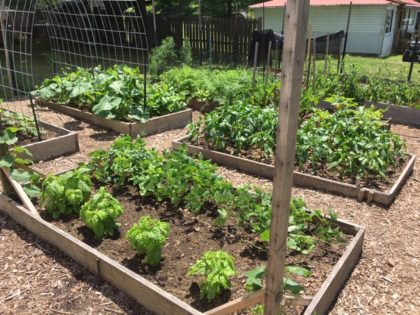
Planning for the 2020 season began with meetings in January and February. Olive barrels, donated by DeLallo Italian Marketplace in Jeannette, were turned into rain barrels, as an additional watering system. Another important addition was native plants around the perimeter of the fence. Attracting and saving pollinators was an additional goal of the group.
Another change occurred. Because of COVID-19, the way to distribute the produce had to be changed since Westmoreland County Food Bank was no longer taking produce donation
2020 By the Numbers*We made 33 distributions of fresh produce (down 13.2% from last year) to four different local aid organizations and food pantries.Our two primary beneficiaries were the End Hunger Café in Latrobe and Ligonier’s Meals on Wheels program. This halving of the number of organizations (down from eight last year) reflected the planting committee’s decision to donate to fewer organizations, thereby potentially increasing our overall benefit to each.Our distributions were comprised of the most diverse range of crops to date, with several “seasons’ bests”:
- 1 pumpkin [new crop]
- 1 lb., 2.75 oz. of basil
- 3 lbs. of snow peas
- 3 lbs., 12 oz. of radishes
- 5 butternut squashes (best to date)
- 5 spaghetti squashes [new crop]
- 5.3 oz. of spinach (“dry” weight, or ~2/3 gal.)
- 6.7 oz. of red & golden beet greens (dry weight, or ~5/6 gal.)
- 8 lbs., 2.3 oz. of mixed lettuces (dry adjusted weight, or ~11.63 gal.; best to date)
- 11 yellow “summer” squash [new crop]
- 14 lbs., 14.4 oz. of “snap”-style bush beans
- 20 parsnips [new crop]
- 20 sprigs of dill [new crop]
- 21 zucchini (best to date)
- 25 cabbages [new crop]
- 35 cucumbers
- 64 red & golden beets (best to date)
- 95 green (and a few green-red) bell peppers (beating last year)
- 103 cherry & slicing tomatoes
- 118 red & yellow onions (best to date)
- 221 carrots


